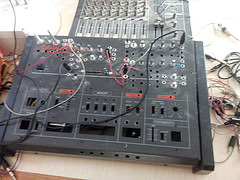Someone on Diaspora asked me: if I only use recorded sounds once, how does this effect sustainability of my music?
This is an interesting question! While the sounds themselves are not recycled, this actually does effect my disk space usage. Once a piece is done, its done and I don’t need the source sounds any more, so I have no need to keep them around. This means that at the end of creating a minute of noise, I have, usually, an uncompressed file and a compressed Mp3 (plus whatever file format the commissioner wants for themselves). A minute of AIFF or WAV runs up to 11 MB and the MP3 is around 1MB, so this really takes up very little hard drive space. (Indeed, the Mp3 could fit on a floppy disk!!)
There are other concerns in sustainability however, one of the most important is e-waste. Every time you get rid of an old computer, it needs to be disposed of without causing pollution. This makes disposal a challenge. Indeed, getting a new laptop involves a fair amount of pollution and may also include conflict minerals. I’d say upgrading hardware is a greater sustainability issue than hard drive space might be. How does this interact with my music?
- Digital Music – This has the greatest potential for e-waste, however, my laptop is already 4 years old and I have no plans to upgrade it, because it is fast enough to do what I want. I write my own programs in SuperCollider to digital audio. When I started doing this, more than a decade ago, I had to be smart about efficiency, so I could get everything to run in real time without maxing out my processor. I really have never run into this issue at all with my current laptop – I feel like the upgrade cycle is now more driven by graphics. I run Ubuntu Studio, which also specifically supports older laptops. Should this laptop die, I would probably get a used one. Indeed, I’d look for the very same one I have now.
- Acoustic – I mentioned using sounds from all kinds of various locations as possibilities in acoustic pieces. However, these were gathered while I was already in the area. I try to avoid flying as much as possible. Since I don’t re-use sounds, putting together an acoustic piece frees up space on my hard drive.
- Analogue – when I bought my synthesiser, 15 years ago, I also bought a computer at the same time. I still use the synthesiser all the time. Analogue hardware doesn’t go obsolete and doesn’t require upgrading. When I get new modules, it’s to add new functionality, not to replace what I’ve already got. For people who want to make electronic music, analogue gear has a higher upfront cost, but outlasts digital. I expect my synth is less than halfway through it’s usable life. Planned obsolescence and the e-waste created by that is just not an issue.
Commissions are ecologically friendly and make great gifts! Digital-download-only commissions are a perfect gift for for Green friends and family who want to avoid clutter. Delivery is guaranteed in time for Hanukkah or Christmas. Order now! The introductory price of £5 will only last until Thursday.
Do you love noise music? Do you have fashion? Drop me an email if you’d like your image to be in forthcoming posts about noise and fashion

 A recycled synth I saw on Sunday.
A recycled synth I saw on Sunday.



